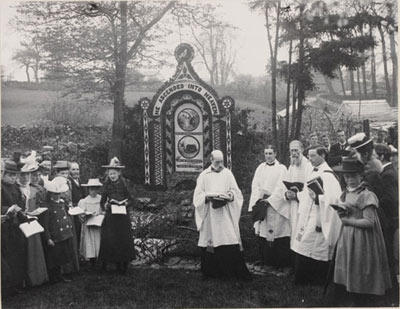Human Flower Project
Thursday, May 17, 2007
Well Dressing on Ascension Day
With mosaics of seeds and flowers, Derbyshire gives thanks for the blessing of water.
 Biblical well dressing
Biblical well dressing
Derbyshire, England
Photo: Discover Derbyshire
By the Christian calendar, today is Ascension. According to the Gospels, Jesus appeared among his disciples forty days after Easter, ordered them to spread the good news—the Great Commission—and then lifted off into the heavens. (We especially like Pietro Perugino’s Italianate version of that event.)
But in Derbyshire, located in England’s north Midlands, the religious miracle is fondly stirred together with a natural wonder: that despite the horrible drought of 1615, the waters of Tissington never ran dry.
“‘There was no rayne fell upon the earth from the 25th day of March till the 2nd day of May, and then there was but one shower; two more fell betweene then and the 4th day of August, so that the greatest part of this land were burnt upp, bothe corn and hay. An ordinary load of hay was at £2, and little or none to be gotte for money.’
“The wells of Tissington were flowing during all this time, and the people for ten miles round drove their cattle to drink at them.”
For that considerable blessing, people here turned Ascension into a festival of thanksgiving and began annually to garland the local wells with flowers—a custom called well dressing.

Well dressing on Ascension Day, May 11, 1899
Tissington, Derbyshire, England
Photo: Sir Benjamin Stone
In all likelihood, the tradition pre-dates the 17th Century’s dry spell, to Roman times (anyone who’s thrown a coin in the Trevi fountain knows how the Romans honor their waters). Perhaps it’s even older, a Celtic pagan custom of spring seedtime, which England’s May-blooming wildflowers made a decorating cinch. (Some sources say that the early church actually banned the practice.) Like so many floral customs—sacred AND secular—well dressing seems to have been revived in the Victorian era. This photograph from 1899 shows a minister and congregation gathered around a decorated ‘coffin’ well in Tissington.
What’s most amazing is that the custom persists in Derbyshire. Today through May 23rd, the wells of Tissington will be adorned with mosaics made of leaves, flowers, and seeds. From what we’ve seen, these human flower projects are largely the work of local schoolchildren.
 Clematis-petal building (detail)
Clematis-petal building (detail)
2002 Brackenfield well dressing
after L.S. Lowry, by students of
Stretton Handley Primary School
Derbyshire, England
Photo: Stretton Handley
Here you can watch an interesting video of how it’s done—a process that involves shaping clay into frames and “pricking out the design with cocktail sticks.” This fine site identifies all the particulars of a wonderful mosaic made by Stretton Handley Primary School with such unorthodox art supplies as peppercorns and lichen. There’s wool for smoke, melon seed for cobblestones, and best of all, lavender clematis petals overlapped for clapboard (or is it dressed stone?).
The well decorations will be ceremonially placed through the week, starting today, visited by processions and blessed by the local bishop. (Of course, it’s become a big tourist attraction too, drawing some 50,000 visitors to the Peak District.)
We understand. Transplanted to green Kentucky from San Angelo, Texas, our mother always beamed on rainy days—to the bafflement of the neighbors. We now live in Texas ourselves, and are discovering the sanctity of water. All to say, the well dressings of Derbyshire—as well as wondrous—are perfectly sensible, too. In American suburbs, we’ve ridden past many a “wishing well” festooned with buckets of petunias. Now Tissington’s tradition puts those funny yard ornaments in a new and grateful light.




